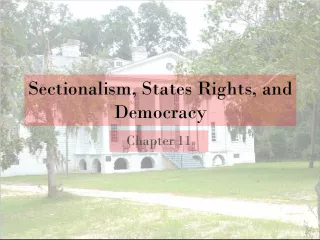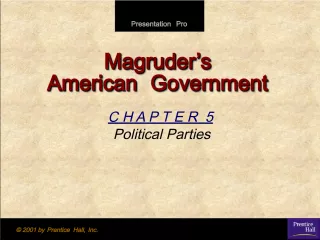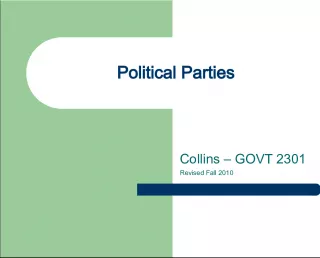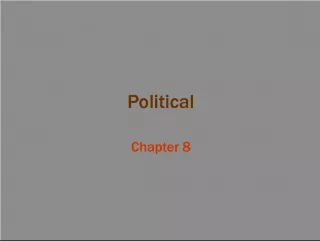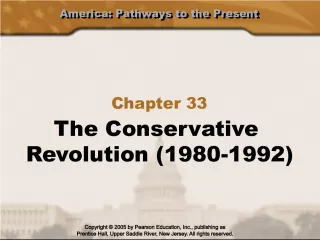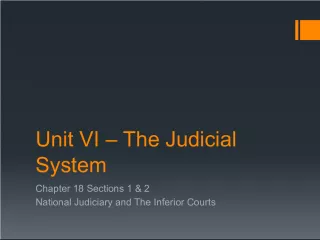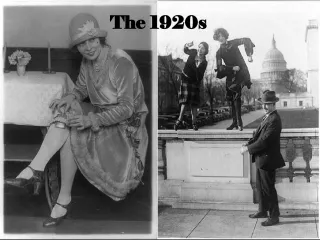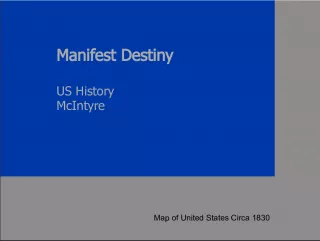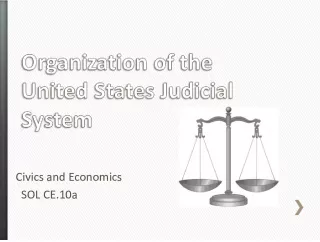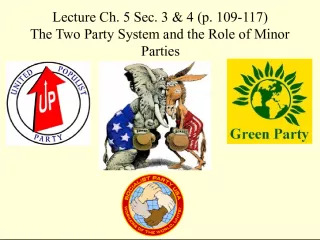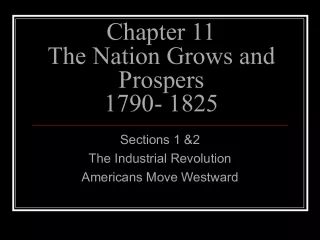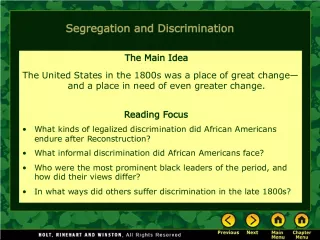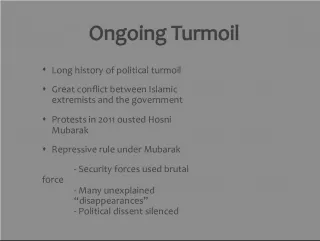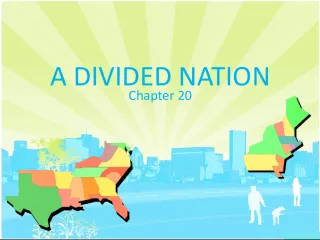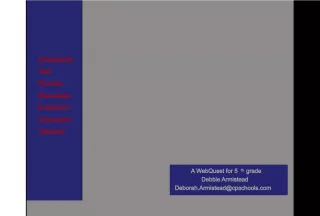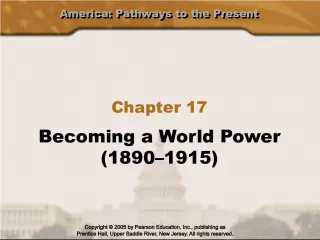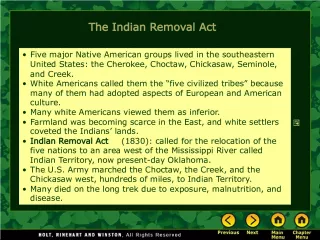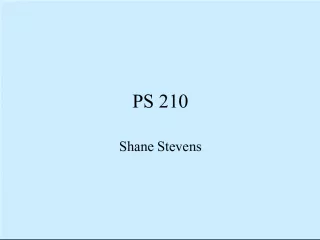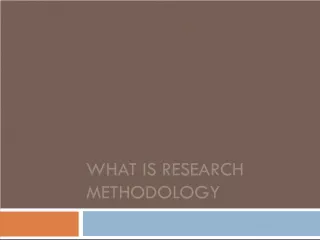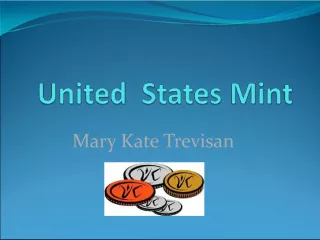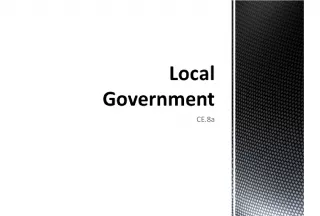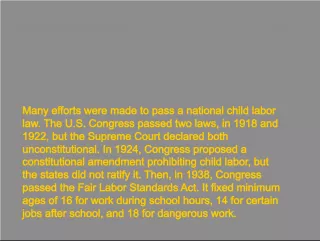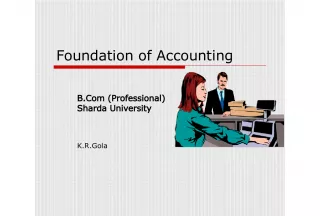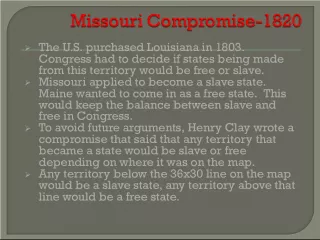Chapter Understanding Political Parties in the United States Chapter


In this chapter, readers will learn about the major political parties in the United States - the Democratic Party and the Republican Party. The chapter will highlight the key issues and beliefs of each
- Uploaded on | 1 Views
-
 kayleesutton
kayleesutton
About Chapter Understanding Political Parties in the United States Chapter
PowerPoint presentation about 'Chapter Understanding Political Parties in the United States Chapter'. This presentation describes the topic on In this chapter, readers will learn about the major political parties in the United States - the Democratic Party and the Republican Party. The chapter will highlight the key issues and beliefs of each. The key topics included in this slideshow are . Download this presentation absolutely free.
Presentation Transcript
Slide1Chapter 16
Slide2BrainstormingMake a Chart listing what you know about each major political party in the United States DEMOCRAT REPUBLICAN Issues Beliefs Major candidates
Slide3PARTIES AND PARTY SYSTEMSPolitical Party : a group of people with broad common interests who organize to win elections, control government, and thereby influence government policies The role that political parties play differs among various nations
Slide4ONE-PARTY SYSTEMS- the party is the government - decisions of party leaders set government policy - political differences arise only within the party - only one party’s candidates on the ballot Cuba, Vietnam, North Korea, China Theocracy: government dominated by religion
Slide5Multiparty SystemNations allowing more than one political party, and usually there are many parties France: 5 major parties Italy: over 10 major parties Ideology: basic belief about government Coalition government: several parties combine forces to obtain a majority for governing
Slide6TWO-PARTY SYSTEMOnly about a dozen nations have systems in which two parties compete for power United States: Democrat Party Republican Party
Slide7GROWTH OF AMERICAN PARTIESFounders distrusted “factions” Early America: FEDERALISTS: strong central government DEMOCRAT-REPUBLICANS: believed states should have more power than central government
Slide8PARTIES BEFORE THE CIVIL WAR1828 Democratic-Republicans split DEMOCRAT: Andrew Jackson WHIGS: other politicians CIVIL WAR: DEMOCRAT: split (Northern / Southern) REPUBLICANS: Abraham Lincoln
Slide9Parties after the Civil WarREPUBLICAN (most Presidents after Civil War) DEMOCRAT (Cleveland, Wilson, FDR) Today, a mixture of these two parties…
Slide10WHICH PARTY IS WHICH?1. They are willing to raise taxes so that the government can provide needed services such as education and defense. 2. This party supports the expansion of business without government assistance or interference. 3. This party calls for the reduction of big government and cutting the budgets of those agencies that have grown too powerful. 4. This party controlled the presidency from the time of the Civil War until after the Stock Market crash, which signaled the start of the Great Depression. 5. This party expanded the role of the federal government in the lives of ordinary people and in the economy when programs were created to fight unemployment and bad business practices during the 1930s.
Slide11Which Party is Which?(con’t)6. This party's presidents were associated with every major military conflict of the 20th century. 7. This party called for respect for the environment, restrictions on big business and its ability to pollute, and a restructuring of the economy to preserve natural resources. 8. Theodore Roosevelt formed this party to enter the 1912 presidential race since the nomination went to President Howard Taft. It was based on controlling the trusts and monopolies that had grown up as a result of the Industrial Revolution. 9. This party supports restrictions on large insurance companies and health management organizations so that the poor and middle class Americans receive adequate health care. 10. This party offered an alternate choice during the 1992 election when Ross Perot mounted a campaign against Bill Clinton and George Bush that gained 20 million popular votes but no electoral votes.
Slide12YOU TUBE VIDEOSDemocratic Videos Channel (Democrat Party) Republican National Committee (rnc’s channel) ***** Comparative Commercials!
Slide13The Role of Minor PartiesTHIRD PARTY: any party other than the two major parties Types: Single-issue party – focus on one issue Ideological party – focus on overall change Splinter party – split off major party
Slide14Obstacles to Third Parties1. Great difficulties in getting on ballots in all 50 states 2. Single-member districts: usually only one candidate wins (in contrast to proportional representation) 3. Financing: most reluctant to contribute
Slide15What is YOUR political partyidentification? DEMOCRAT REPUBLICAN OTHER / THIRD PARTY WHY??? – Survey…
Slide16Political SurveySURVEY at least five people (due by March 2). The results will be anonymous. SIX QUESTIONS : 1. What is your political party affiliation? 2. Why do you belong to your party? 3. Do you consider yourself conservative, moderate, or liberal? 4. Who are two of your political “heroes”? 5. Have you or would you ever vote for someone of another party? 6. Name three current elected officials.
Slide17POLITICAL SPECTRUMPowerpoint Youtube videos: “Political Spectrum” – “Political Ideology”
Slide18PARTY ORGANIZATIONPolitical Party must have a dedicated core of willing volunteers Parties also use various professionals (like WHO? For WHAT?)
Slide19MEMBERSHIP & ORGANIZATIONDemocrats and Republicans are organized into 50 state parties and thousands of local parties How does one “join” a party? DECLARE PARTY PREFERENCE WHEN REGISTERING TO VOTE Varying degrees of participation…
Slide20LOCAL PARTY ORGANIZATIONPRECINCT: basic local unit – voting district ranging in size from a few voters to more than 1,000 Precinct Captain: organizes party workers Party County Chairperson (see CHART on page 459)
Slide21STATE PARTY ORGANIZATIONSTATE CENTRAL COMMITTEE Democrat Party of Kentucky Republican Party of Kentucky Purpose: help elect party’s candidates for state government offices
Slide22NATIONAL PARTY ORGANIZATIONNational Convention: gathering of party members and local and state party officials – meets every four years to nominate party’s presidential and vice-presidential candidates National Committee: large group composed of representatives from 50 state party organizations – runs the party DNC & RNC
Slide23POLITICAL PARTY FUNCTIONS1. Recruiting Candidates – elections 2. Educating the Public – bring issues to public’s attention 3. Operating the government – running & staffing government 4. Dispensing patronage – favors / rewards 5. Loyal opposition – “watchdog” 6. Reduction of conflict – encourages compromise and working together
Slide24NOMINATING CANDIDATESHOW CANDIDATES ARE SELECTED 1. CAUCUSES: private meetings of party leaders 2. NOMINATING CONVENTIONS: public meeting of party’s to choose candidates 3. PRIMARY ELECTIONS: primary to choose candidates (direct / open / closed)
Slide25PRESIDENTIAL NOMINATIONSEvery 4 years, each major party gathers in summer to select a TICKET, candidates for president and vice president Shift from caucuses to nominating conventions in American history PRESIDENTIAL PRIMARIES
Slide26National Convention
